
The roots of the Detroit Red Wings go all the way back to the old Western Hockey League, where the Victoria (British Columbia) Cougars were members until their roster was sold to a group from Detroit on September 25, 1926. The Detroit group had been awarded an NHL franchise on May 15, 1926.

The team began to play as the Detroit Cougars in the fall of 1926 while playing its home games in Windsor, Ontario. Despite the fact that the Victoria Cougars had won the Stanley Cup in 1925 and were Cup finalists in 1926, the Detroit Cougars finished 12-28-4; the NHL's worst record for the 1926-27 season.

Help came, the following season, in the form of Jack Adams as the team's new coach and GM. Adams had played in the old Pacific Coast league and in the NHL with the Toronto St. Pats and the Ottawa Senators. Adam's tenure as coach and GM would last until the 1962-63 season, when Sid Abel took over.
The team also moved into the brand new Olympia Stadium for the 1927-28 season. A Detroit and professional hockey landmark, the Olympia would serve as the home for the franchise through the midway point of the 1979-80 season. With Adams at the helm, the team made the playoffs for the first time in franchise history (1928-29).
Willing to try anything, Jack Adams changed the name for the 1930-31 season to the Detroit Falcons.

After the depression, the team went into receivership and Adams was forced to use his own money to make payroll. It was so bad financially, that Adams joked if the Montreal Canadiens superstar Howie Morenz were available for $1.98, the Falcons still couldn't afford him. Things weren't much better on the ice as the team had only made the playoffs twice in its first six seasons.
In 1932 the financial problems ended when grain millionaire and shipping magnate James Norris Sr. purchased the team. Norris, like Adams, was a Canadian turned American. He had once played hockey for the Montreal Amateur Athletic Association's Winged Wheelers.
When the two men met, Norris and Adams agreed that the team's new logo would be a winged wheel and the club's nickname changed to the Red Wings.
James Norris

Even though the Red Wings missed the playoffs in 1934-35, Jack Adams knew his recipe for success was nearing completion.
The Detroit Red Wings manager moved to add the final ingredients before the 1935-36 season commenced. His bold step to deal all-star center Cooney Weiland to Boston for Marty Barry, inserting Barry as his No. 1 pivot between Larry Aurie and Herbie Lewis, paid huge dividends when Barry’s 21-19-40 totals left him second in NHL scoring. Linemate Lewis (14-23-37) finished ninth in the NHL points race.
Role players Hec Kilrea and Pete Kelly were also picked up and would make huge contributions. Ralph (Scotty) Bowman, a late-season acquisition in 1934-35 and heavy-hitting Bucko McDonald, who finished second in the voting for NHL rookie of the year, solidified the defense, while Normie Smith matured into a front-line NHL goalie.
The Wings finished atop the tough American Division, in which all four teams collected at least 50 points during the 48-game campaign. The Canadian Division champion Montreal Maroons provided opening-round playoff opposition, with the winner of this first-place showdown advancing directly to the Stanley Cup final.
Syd Howe

The first game of that series is still talked about today. It lasted an NHL-record 176 minutes and 30 seconds on the game clock and nearly six hours in real time before rookie Mud Bruneteau tallied the only goal on a pass from Kilrea.
Blasting their way to the final with a three-game sweep of the Montreal Maroons, only arch-rival Toronto stood in the way and Detroit set out to make short work of the Maple Leafs, whipping them 3-1 and 9-4 in the first two games at the Olympia. The nine goals were a single-game playoff record for the Wings.
Kelly’s goal at 9:48 of the third period in Detroit’s 3-2 win in Game 4 stood as the Wings’ first Cup-winning tally.
"Winning the Stanley Cup was the one ambition of my life," Wings owner James Norris said as he filled the mug’s bowl with champagne. Everyone took a sip, including Adams, who had never before taken a drink of alcohol in his life.
Herbie Lewis

Toronto rallied from a 3-0 deficit with 6:50 to play in regulation time in Game 4, winning 4-3 on Buzz Boll’s overtime marker, but the setback was temporary. The Wings overcame a first-period goal by Leafs center Joe Primeau, racing to a 3-1 lead. They held on for a 3-2 verdict and the first championship in franchise history.
"Every player on the team has taken a turn at bringing the house down in these playoffs," Adams said. "I never saw anything like it."
An overflow crowd at Michigan Central Train Station greeted the team upon its return from Toronto the next day and a police escort helped Adams carry the Cup to safety through the revellers, but not before he promised them there would be more to celebrate next spring.
Ebbie Goodfellow

"Don’t be surprised if the Wings make it two in a row," Adams boldly predicted. "I hope they make it a habit."
The Red Wings went on to repeat as Cup Champions in 1937, winning three games-to-two over the New York Rangers in the finals.
Normie Smith

Scores from the historic final were as follows:
April 5, 1936: Detroit 3 Toronto 1
April 7, 1936: Detroit 9 Toronto 4
April 9, 1936: Toronto 4 Detroit 3 (Buzz Boll 0:31 OT)
April 11, 1936 Detroit 3 Toronto 2 (Pete Kelly 9:45 3rd)
The first two games played at the Detroit Olympia, the final two games at Maple Leaf Gardens.
After the final bell, the Leafs players all dropped their sticks spontaneously and skated over to the Red Wings players to offer their congratulations. This was a remarkable victory given that Detroit's first playoff game lasted 116:30 into overtime against the Montreal Maroons, the longest game ever (won 1-0 by the Wings). Detroit had finished in last place the previous season.
The Stanley Cup was not presented to the Red Wings on the ice, but later that evening at a ceremony held at the Royal York Hotel in Toronto by league president Frank Calder. The Cup was first handed to owner james Norris and was filled soon after with champagne.
Each player was given a ring to commemerate the victory. On April 18th, the festivities continued with a lavish banquet at the Masonic Temple in Detroit.
Syd Howe's (2-3-5) name is spelled "Sid" on the Cup, he later changed his name to "Syd". Howe was the first player in the NHL era to score six goals in one game on Febuary 3, 1944.
John Sorrell (2-3-5) was in his sixth season with the Red Wings and did not play in the league until he was 24 years old. Sorrell was a slim 5' 11", 155lbs.
Marry Barry (2-2-4) was aquired from the Bruins for Cooney Weiland and played on a line with Larry Aurie and Herbie Lewis. After the war, Barry coached St. Mary's junior team in Halifax. He died of a heart atack in 1969.
Gord Pettinger (2-2-4) spent four seasons with Detroit, winning two Cups. His brother Eric was a brief NHL'er from 1928 to 1931.
Bucko McDonald (3-0-3) was a lacrosse pro in his late teens while playing minor league hockey. A big, solid defenseman, McDonald had not played in a year when the red Wings offered him a contract. He surprised many by making the team on his very first try. McDonald is just as well known today for being Bobby Orr's coach when the budding phenom was just a young lad.
Hec Kilrea (0-2-2) was called "General" on the original Cup band. Nine Years prior, he had teamed with GM and coach Jack Adams in winning the Cup with the Ottawa Senators.
Wally Kilrea (2-1-3) , Hec's brother, just missed playing with another brother by two seasons. Retiring in 1937-38, Wally's sibling Ken Kilrea joined the Wings in 1938-39.
Modere "Mud" Bruneteau (1-2-3) scored the historic 1-0 goal in the longest game ever played against the Montreal Maroons in the opening round. The morning following the game, Maroons goalie Lorne Chabot presented Mud with the historic puck. It was a terrific gesture of sportsmanship the Bruneteau remembered for the remainder of his life.
Herbie Lewis (1-2-3) played in the Ace Bailey benefit game in 1934. According to coach Adams, "Lewis is a sportsman of the highest type. I defy baseball, football, or boxing to produce an individual who can eclipse Herbie Lewis as a perfect role model for what an athlete should stand for."
Ralph "Scotty" Bowman (1-1-2) was claimed by GM Adams for the St. Louis Eagles, who disbanded prior to the start of the season. Bowman played his youth hockey with teams in the Parkdale and Niagara Falls areas. He is of no relation to modern day coach William "Scotty" Bowman.
Pete Kelly's (1-1-2) Cup winning goal came quite serendipitously. "It wasn't my shift", he admitted. "But Larry Aurie, who was the right winger on our scoring line, was limping to the bench at the end of a long shift and i jumped over the boards without waiting for Jack Adams to tell me to go. I got a pass from Herbie Lewis and I just shot it in the top corner of the net." The victim was Leafs goalie George Hainsworth.
In a game on Febuary 24, 1935, Wings captain Doug Young (0-2-2) swung at a puck near the boards and missed, instead hitting a fan named Mrs. Doris Geldhart. The stick broke the ladies nose and blackened both eyes. She sued him, unsuccessfully, for the sum of $25,000.
Ebbie Goodfellow (1-0-1) spent six years as a forward before suiting up as a defenseman for the Red Wings. Equally skilled in both ends, he tied the final game at 1-1 in the second period on a Sorrell pass, before splitting the D for the goal.
Larry Aurie (0-1-1) broke his collarbone in a game on Febuary 18th. Seemingly gone for the season, Aurie missed o nly four games before returning.
Goaltender Normie Smith played all 48 games during the regular season, allowing only 103 goals. During that time he had a shutout streak that lasted 248:32. In the final, he posted a 2.74 GAA with 11 goals allowed in 241 minutes of play.The Montreal Maroons gave up on Smith, but he refused to give up anything to them. Smith’s original team provided Detroit’s opposition in the opening round of the 1936 playoffs and in Game 1 of the series, which lasted an NHL-record 176:30, the Detroit goalie threw a brick wall up in front of his cage, blocking 89 shots for a 1-0 win. He also blanked the Maroons 3-0 in Game 2. Backstopping Detroit to a four-game decision over Toronto and the first Stanley Cup in club history, Smith led all goalies in wins (six) and shutouts (two) during the playoffs.
Coach and GM Jack Adams began his career as a player with Toronto in 1917, winning the Cup in the NHL's inaugural season. He joined the Red Wings in 1927 and the affiliation lasted 35 years and produced 7 Stanley Cups.
Red Wings team president James Norris made his fortune via the Norris Grain Co. of Chicago. He had wanrted to buy an NHL team for that city, but when rebuffed he settled for Detroit in 1933. He changed the teams name from Falcons (previously Cougars) to Red Wings and based the logo on that of the Montreal Winged Wheels hockey team of his youth while growing up in Montreal. Later, in an era where conflict of interest bylaws were a foreign concept, Norris held power in the Detroit Olympia, Madison Square Garden, and the Chicago Stadium. It gave rise to jokes that NHL actually was an acronym for the Norris Hockey League.

(Note - It may be purely coincidental that as I am posting on the Detroit Red Wings, that they currently sit atop of the NHL standings. It's not entirely odd, however, as they have tended to be there for the better part of the last decede. In those ten years, I have often found myself cheering for the Wings in the post season, calling them my second favorite team. While my favorite Montreal Canadiens have had a decade of dubious achievements, the Wings have hauled in three Stanley Cup wins and given me many thrills along the way. My liking the Winged Wheels goes back to my youth. I guess I just had a thing for red hockey jerseys - the Blackhawks sweaters are still, in my eyes, a most beautiful sight. As the 1995 playoffs approached, a pool bar that I frequented at the time was selling almost 50 hockey jerseys one night - real cheap too! Seems that the bar's owner also dealt in bankruptcies and purchased stock in a failed sporting goods store. Above a rack of sweaters read a sign that said "75% Off", and all the jerseys were priced between $10 and $15 - I went hog wild and bought three on the spot. Unfortunately, there were no Canadiens jerseys available for me to grab, while more than 30 of them were home and away Leafs replica's. Small wonder the dude went bankrpupt! I walked away with a Sharks and Blackhawks away jerseys, and a shining white Red Wings home jersey. Total price - $36.00. The only bad news was, I was out of beer and pool money. Had I been smarter, I'd have bought three Maple Leafs sweaters, resold them for a quick profit, and gone back the following morning to clean up even better! Oh well, you live and learn. Wearing the sweater for a day or two, oddly helped me win a bet. I had gotten the number 95 ironed onto the back as that would be, in my esteem, the year the Wings Cup drought would end. Why I didn't get Stevie Y's 19 on it, I'll never know, but it seemed a cool idea at the time. These days people wonder why I am a Denny Markov fan. As the '95 final drew close, the best team to me seemed to be the New Jersey Devils. Wearing the Wings jersey one day, I was asked by a Wings supporter, how I thought the final would play out. Feeling slightly foolish inside the 95, my hockey mind spoke against my heart, as I claimed the Devils in 5. Greeted with roaring laughter and a wager, I explained that since the strike shortened season meant the opponants had not met all season, my money was on the more defensive team. As history recalls, a 4 game sweep made me look brilliant, while my heart broke and I pocketed $20. Two years later, I was almost wearing the thing out!)





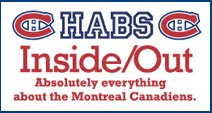





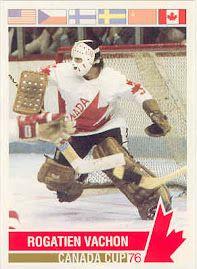
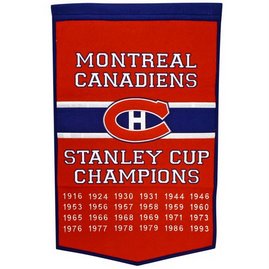







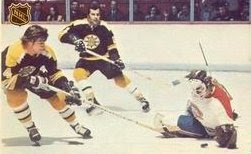



















































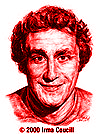



































































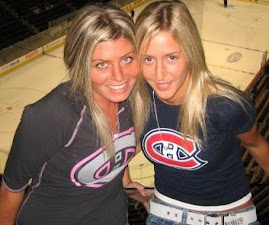


















No comments:
Post a Comment